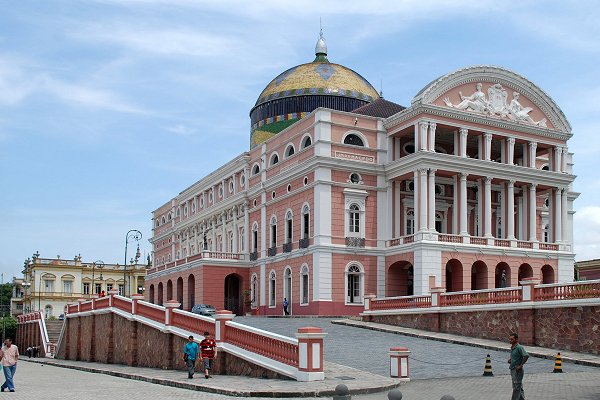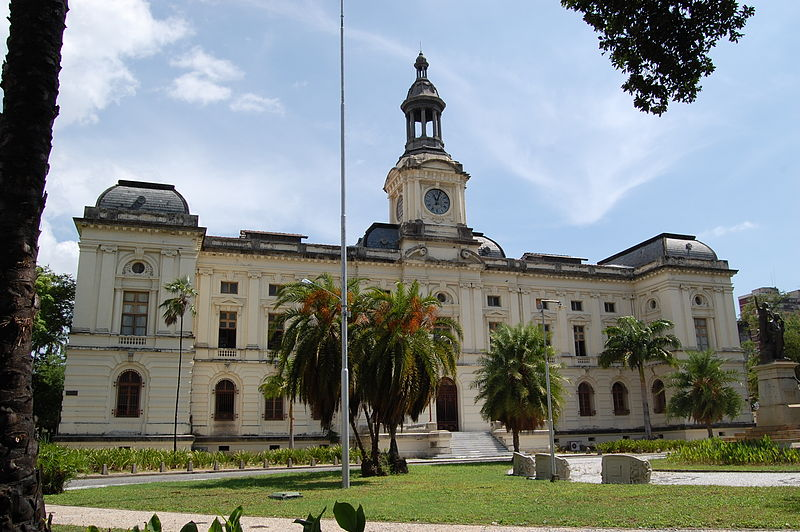Teatro Amazonas Energy Pilot
The project will be deployed in the Teatro Amazonas Opera House  as an attractive showcase to demonstrate the potential of the smart system for reducing energy usage and CO2 footprint in an existing public building, that obviously allows no significant retrofitting and construction works. as an attractive showcase to demonstrate the potential of the smart system for reducing energy usage and CO2 footprint in an existing public building, that obviously allows no significant retrofitting and construction works.
IMPReSS platform will allow developers to integrate the legacy system and use the available building blocks, orchestrate them to create an intelligent energy management system that relais on natural resources (like daylight and solar energy) and control the operation of both passive and active environmental systems to ensure the best possible comfort conditions with the most efficient use of energy.
The intelligent Energy monitoring and smart control of appliances at the Teatro Amazonas will effortlessly optimize efficiently the energy usage without compromising comfort or convenience and simultaneously provide a platform with an enormous publicity potential establishing the necessary public awareness to change the attitude towards energy usage and CO2 footprint and creating a wide public base for necessary changes in actual human behavior to realize long-term energy savings. The demonstration will use its real-time energy-awareness services for all users of the Teatro Amazonas.
Additionally this showcase will be a figurehead with enormous potential creating international awareness far beyond the Teatro Amazonas, the City of Manaus and Amazonas State and moreover create a touristic attraction on its own, showing a successful integration of national historic heritage and green awareness and ecological sustainability.
These ideas for concrete application in this scenario will be further investigated in the project:
 • LED-light-based real-time ambient energy awareness in the Lobby and in the public spaces around the Teatro Amazonas. • LED-light-based real-time ambient energy awareness in the Lobby and in the public spaces around the Teatro Amazonas.
 • Public interactive displays informing about details of the savings. • Public interactive displays informing about details of the savings.
 • Additional information material on how to realize energy saving with easy behavior changes at the own home etc. • Additional information material on how to realize energy saving with easy behavior changes at the own home etc.
 • Reporting of energy saving related activities of the Teatro Amazonas staff and of similar activities from the staff e.g. from the employees of the Valentino Castle in Turin competing with Manaus etc. • Reporting of energy saving related activities of the Teatro Amazonas staff and of similar activities from the staff e.g. from the employees of the Valentino Castle in Turin competing with Manaus etc.
University Energy Pilot
 The University Campus has two energy measurement cabins covering 13.8 kV primary voltage distributions. Implemented as early as 2003, these are supplied by the local energy distributer company and represent the Campus energy connections to the outside world. Billing is based on the readings at these two entry cabins which causes a serious lack of high granularity intra-campus energy consumption data. The first cabin manages 40% of the total load currently reaching 2,900 kW whereas the second cabin leads with the remaining 60% which also represent 4,450kW. The concentrated supply system offers little sectoring and is purely radial. As a result, when a failure takes place somewhere, there is little possibility for isolating this and confining to a small area. Despite the lack of flexibility, work is underway to install the University´s first substation operating at 69kV. The university managed digital energy measurement devices. These have so far been only installed in the large consumption Campus sites which number currently totals 14. This move allows some limited remote readings and simple monitoring of energy consumption.
The University Campus has two energy measurement cabins covering 13.8 kV primary voltage distributions. Implemented as early as 2003, these are supplied by the local energy distributer company and represent the Campus energy connections to the outside world. Billing is based on the readings at these two entry cabins which causes a serious lack of high granularity intra-campus energy consumption data. The first cabin manages 40% of the total load currently reaching 2,900 kW whereas the second cabin leads with the remaining 60% which also represent 4,450kW. The concentrated supply system offers little sectoring and is purely radial. As a result, when a failure takes place somewhere, there is little possibility for isolating this and confining to a small area. Despite the lack of flexibility, work is underway to install the University´s first substation operating at 69kV. The university managed digital energy measurement devices. These have so far been only installed in the large consumption Campus sites which number currently totals 14. This move allows some limited remote readings and simple monitoring of energy consumption.
In this project pilot we look to provide a sustainable LinkSmart based energy management framework addressing reduction in energy usage and CO2 footprint over the UFPE Campus. Through this proposed Campus piloting of our ideas, we can expect to see reduction up to 10-15% in energy consumption.
For this scenario, the following specific action points are planned in the project:
 • Different critical applications accessing shared sensors, actuators, and energy supply services such as personal monitoring app, centralized energy policy, safety critical equipment. • Different critical applications accessing shared sensors, actuators, and energy supply services such as personal monitoring app, centralized energy policy, safety critical equipment.
 • Support for real-time trending and monitoring of energy consumption and production of a map energy showing the hotspots (locations with high consumption) and the prediction for future infrastructural investments. • Support for real-time trending and monitoring of energy consumption and production of a map energy showing the hotspots (locations with high consumption) and the prediction for future infrastructural investments.
 • Design and evaluate an automatic and consistent reaction to energy events such as device failure, unbalanced distribution, programmed maintenance, etc. • Design and evaluate an automatic and consistent reaction to energy events such as device failure, unbalanced distribution, programmed maintenance, etc.
 • Improve system reliability by adding redundant components such as sensors, network links connecting all energy devices and the distribution of decision making through LinkSmart. • Improve system reliability by adding redundant components such as sensors, network links connecting all energy devices and the distribution of decision making through LinkSmart.
 • The use of LED-light-based real-time ambient energy awareness in the Lobby and in the public spaces; • The use of LED-light-based real-time ambient energy awareness in the Lobby and in the public spaces;
 • The deployment of public interactive displays informing about details of the savings; • The deployment of public interactive displays informing about details of the savings;
 • The use of business level policies to guide and ease the management of energy related devices, storage units, meters, etc. • The use of business level policies to guide and ease the management of energy related devices, storage units, meters, etc.
 • The ubiquitous introduction of LinkSmart managed advanced energy storage units on Campus. The pilot should prove that their cost oriented use so that cheaper energy may be purchased and stored during off-peak hours and distributed during high consumption hours. A publish subscribe model may be used to dynamically manage the distribution of stored energy among the different storage and consumption sites. The pilot will invest into flywheels, electrochemical capacitors, and mature storage technologies such as conventional pumped hydro, compressed air and lead-acid batteries. A detailed analysis should be carried out to estimate the requirements for electricity storage across the whole campus power system and its “corresponding value” to the University. • The ubiquitous introduction of LinkSmart managed advanced energy storage units on Campus. The pilot should prove that their cost oriented use so that cheaper energy may be purchased and stored during off-peak hours and distributed during high consumption hours. A publish subscribe model may be used to dynamically manage the distribution of stored energy among the different storage and consumption sites. The pilot will invest into flywheels, electrochemical capacitors, and mature storage technologies such as conventional pumped hydro, compressed air and lead-acid batteries. A detailed analysis should be carried out to estimate the requirements for electricity storage across the whole campus power system and its “corresponding value” to the University.
 • Integrating the LinkSmart platform through a SCADA Gateway hence enabling real-time interaction with external energy supplier entities including our project partner CHESF. • Integrating the LinkSmart platform through a SCADA Gateway hence enabling real-time interaction with external energy supplier entities including our project partner CHESF.
|




